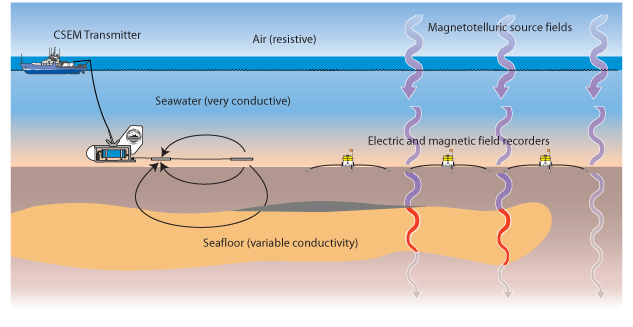 |
 |

|
 |
Research | Concepts | CSEM and MT Exploration for Petroleum

Concept diagram for the marine controlled source EM (CSEM) and marine magnetotelluric
(MT) method.
There are two basic marine EM techniques currently
in use for hydrocarbon exploration: the broadband marine magnetotelluric
method (MT) and the controlled source EM (CSEM) method. In the MT method, seafloor
recordings of Earth’s naturally occurring electric and magnetic fields
are used to estimate the electrical conductivity of the seafloor geology to
depths of about 10 kilometers. In the CSEM method, a
deep-towed electric field dipole is used to broadcast a controlled EM energy signal through the subsurface
and back to an array of seafloor
receivers, with sensitivity to structures
at shallower depths than the MT method. While the MT method is preferentially
sensitive to conductive structures, the CSEM method is preferentially sensitive
to resistive structures, and in particular can detect the thin resistive layers
of a gas reservoir (Wright et al., 2002; Rosten et al., 2003). Unlike the MT
method, in which the ionospheric source of energy is mainly one dimensional
(1D), the CSEM method uses a transmitter which generates a 3D source of energy,
and so calculating the CSEM response over a 2D geological structure is usually
termed a 2.5D problem (3D source plus 2D model).
|
|
|
 |
 |
Last updated: Wednesday, 06-May-2009 14:40:10 PDT
email: sconstable@ucsd.edu
|
|